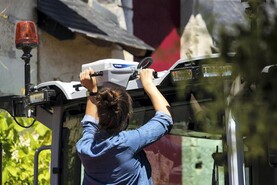Since the mid-1990s, students between the ages of 14 and 16 have been taking part in FRS Network's safe tractor driving course.
Although over 200 students take part in the course annually, there is scope for more students to participate, according to national health and safety manager at FRS Network Jim Dockery.
"It's the only one of its kind in this country for this age group and it's an off-road course, because obviously you need to be 16 to drive on the road," Dockery said.
The course takes place over one school day and teaches participants about carrying out various safety checks and raises awareness of the dangers of driving machinery.
FBD is the main insurers of the programme and it is run by FRS Networks in conjunction with the Health and Safety Authority.
Course breakdown
For the first element of the course, students must initially do a visual assessment of the tractor. This involves checking it for oil, diesel, water and checking the condition of the mirrors, cab and tyres, etc.
Students are also taught how to adjust the seat and the steering wheel in order to set themselves up properly before driving.
"It seems like a very simple thing, but it's very important. Modern tractors now have steering wheels that adjust up and down just like your car," Dockery said.
Other "basic skills" that are developed according to Dockery are getting up and down out of the tractor which involves facing the tractor getting up and facing it getting down again.
Driving
Every student must drive and reverse a tractor with some sort of implement attached, for example a tanker or a trailer.
They must also learn how to attach and detach the implement properly also.
"When they are driving, they must be watching mirrors and looking all around them as part of the assessment.
"It's not about speed or it's not about a snail's pace either - it's about selecting an appropriate speed to suit the conditions you are in," he said.
The students are put through their paces and are made reverse through cones with the implement on the back.
"You often see young people spinning the wheel left and right really fast when they are reversing. There's no need for this, so we make them do it again for 20 or 30 yards with minimal movements of the wheel and they have much better control," he said.
Driving and reversing are the main elements of the course and there is a lot of focus placed on correct parking.
Leaving down the front loader is the most important lesson, Dockery said, adding that there has been numerous accidents on farms where the loader was left up and children were involved in accidents.
The course ties in with bus times and lasts from about 9.30am to 3.30pm.
FRS will organise the venue, the insurance and the tractor. However, Dockery said that a school with a big enough basketball court would also do fine.
"Some schools have been participating for years, for example Frances Dowling is an ag science teacher in St Brendan's Community School in Birr and she has been sending kids on the course for years and years.
"There's a network of tutors out there that can train in any school in the country once there's a group of 12 or 14 students," he said.






 This is a subscriber-only article
This is a subscriber-only article










SHARING OPTIONS: